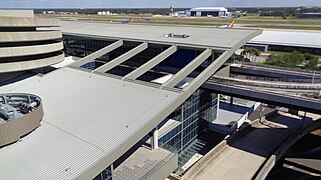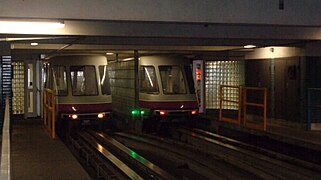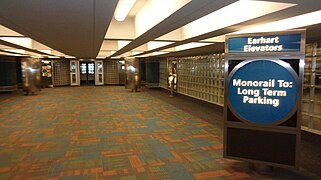Tampa International Airport People Movers
| Tampa International Airport People Movers | ||||||||||||||||||||||||||||||||||||||||||||||||||||||||||||||||||||||||||||||||||||||||||||||||||||||||||||||||||||||||||||||||||||||||||||||||||||||||||||||||
|---|---|---|---|---|---|---|---|---|---|---|---|---|---|---|---|---|---|---|---|---|---|---|---|---|---|---|---|---|---|---|---|---|---|---|---|---|---|---|---|---|---|---|---|---|---|---|---|---|---|---|---|---|---|---|---|---|---|---|---|---|---|---|---|---|---|---|---|---|---|---|---|---|---|---|---|---|---|---|---|---|---|---|---|---|---|---|---|---|---|---|---|---|---|---|---|---|---|---|---|---|---|---|---|---|---|---|---|---|---|---|---|---|---|---|---|---|---|---|---|---|---|---|---|---|---|---|---|---|---|---|---|---|---|---|---|---|---|---|---|---|---|---|---|---|---|---|---|---|---|---|---|---|---|---|---|---|---|---|---|---|
 SkyConnect (left) and Airside A (right) people movers | ||||||||||||||||||||||||||||||||||||||||||||||||||||||||||||||||||||||||||||||||||||||||||||||||||||||||||||||||||||||||||||||||||||||||||||||||||||||||||||||||
| Overview | ||||||||||||||||||||||||||||||||||||||||||||||||||||||||||||||||||||||||||||||||||||||||||||||||||||||||||||||||||||||||||||||||||||||||||||||||||||||||||||||||
| Locale | Tampa International Airport | |||||||||||||||||||||||||||||||||||||||||||||||||||||||||||||||||||||||||||||||||||||||||||||||||||||||||||||||||||||||||||||||||||||||||||||||||||||||||||||||
| Stations | 11 | |||||||||||||||||||||||||||||||||||||||||||||||||||||||||||||||||||||||||||||||||||||||||||||||||||||||||||||||||||||||||||||||||||||||||||||||||||||||||||||||
| Service | ||||||||||||||||||||||||||||||||||||||||||||||||||||||||||||||||||||||||||||||||||||||||||||||||||||||||||||||||||||||||||||||||||||||||||||||||||||||||||||||||
| Type | Automated guideway transit | |||||||||||||||||||||||||||||||||||||||||||||||||||||||||||||||||||||||||||||||||||||||||||||||||||||||||||||||||||||||||||||||||||||||||||||||||||||||||||||||
| Services | 5 | |||||||||||||||||||||||||||||||||||||||||||||||||||||||||||||||||||||||||||||||||||||||||||||||||||||||||||||||||||||||||||||||||||||||||||||||||||||||||||||||
| Rolling stock |
| |||||||||||||||||||||||||||||||||||||||||||||||||||||||||||||||||||||||||||||||||||||||||||||||||||||||||||||||||||||||||||||||||||||||||||||||||||||||||||||||
| History | ||||||||||||||||||||||||||||||||||||||||||||||||||||||||||||||||||||||||||||||||||||||||||||||||||||||||||||||||||||||||||||||||||||||||||||||||||||||||||||||||
| Opened | 1971 (airside systems) 1991 (monorail) 2018 (SkyConnect) | |||||||||||||||||||||||||||||||||||||||||||||||||||||||||||||||||||||||||||||||||||||||||||||||||||||||||||||||||||||||||||||||||||||||||||||||||||||||||||||||
| Closed | 2020 (monorail)[2] | |||||||||||||||||||||||||||||||||||||||||||||||||||||||||||||||||||||||||||||||||||||||||||||||||||||||||||||||||||||||||||||||||||||||||||||||||||||||||||||||
| ||||||||||||||||||||||||||||||||||||||||||||||||||||||||||||||||||||||||||||||||||||||||||||||||||||||||||||||||||||||||||||||||||||||||||||||||||||||||||||||||
The Tampa International Airport People Movers are a set of automated people mover systems operating within Tampa International Airport. The primary set of people movers are automated guideway transit (AGT) systems that connect the airport's main terminal to four satellite airside concourses. Opened in 1971, it is the first automated people mover system in the world built within an airport. A monorail connected the main terminal and the long-term parking garage from 1991 until its closure in 2020. A fifth AGT line known as SkyConnect began operating in 2018, and connects the main terminal with the airport's economy parking garage and rental car center.
Landside/Airside shuttles[]

The four currently operating airside automated guideway transit (AGT) people mover systems operate as shuttles connecting the main terminal on Level 3 to airside concourses A, C, E, and F. Each line consists of two guideways with an emergency walkway between the two guideways (which can be used to evacuate a shuttle or be used for people to walk if the shuttles fail). On each line, each guideway currently carries a two-car train (one red train and one blue train) consisting of Bombardier Innovia APM 100 vehicles. The shuttles simply run back and forth between the main terminal and the airsides buildings. Passengers board on an island platform between the two guideways and disembark on side platforms at both ends. Their layout is similar to the landside/airside shuttle systems of the Orlando International Airport People Movers.
Tampa Mayor Jane Castor delivers greetings to travelers on the shuttles.[3] Tampa's previous mayor Bob Buckhorn also provided these greetings during his tenure as Mayor of Tampa.[4]
History[]

When the terminal opened in 1971, the landside/airside shuttles were the first automated people mover systems to operate in an airport. It is today Bombardier Transportation's longest-running automated people mover system.
The landside/airside shuttles were originally built by Westinghouse Electric Corporation (who was also contracted to install the terminal's original elevators and escalators). The system initially included lines to Airsides B, C, D, and E using eight first-generation Westinghouse C-100 vehicles (one vehicle on each guideway).[5] The shuttle stations on the original airsides were located on third level of the airside buildings.[6]
Airside F was added in 1987 and its shuttles included new second-generation C-100 vehicles. Airside F would also be the first airside system to include two-car trains.[7]

Airside B closed permanently in 1991. In lieu of reopening Airside B, Airside A was built in 1995. Airside A's shuttle system has operated with CX-100 vehicles (known today as the Bombardier Innovia APM 100) since its opening and it operates with two-car trains. Despite the demolition of the Airside B building in 2003, the people mover guideway to the former Airside B still remains abandoned at the airport today.[7]

In 1996, the original Airside C and Airside D were renovated. As part of the renovation, the original vehicles on their people movers were replaced with CX-100 vehicles. Upon completion of the renovations, the original Airside E closed, and the last of the airport's original people mover vehicles were retired.[7]
Airside E was rebuilt in 2002, and its new shuttles included CX-100 vehicles running in two-car trains. Airside C was then demolished and rebuilt. Airside C's CX-100 vehicles, which were installed in 1996, were refurbished and resumed service when the rebuilt Airside C opened in April of 2005.
One month after Airside C reopened, Airside D closed permanently. Airside D's CX-100 vehicles, which were also installed in 1996, were refurbished and were relocated to Airside C, where they were used to expand the Airside C's shuttles to two-car trains. Airside D was demolished in 2007, though the shuttle infrastructure was left in place for another decade.[8]
Airside F's second-generation C-100 vehicles were replaced with CX-100 vehicles by Bombardier (who has since acquired the remains of Westinghouse's transportation department) in 2008.[8]
In 2018, work was complete to remodel the main terminal. As part of the renovation, the shuttle stations were rebuilt and moved outward to give the center of the building more space on Level 3. The Airside D shuttle station, which had been simply roped off since its closure, was also removed at the same time and was replaced with a food court.[9] The rest of the Airside D guideway was demolished in 2019.[10]
Future[]
On November 4, 2021, it was announced that the existing CX-100 vehicles on Airsides A and C (which have been in service since 1996) will be replaced with new vehicles. Alstom, which acquired Bombardier's transportation division in 2021, will supply the new trains which will debut in 2025. The airport also plans to rebuild Airside D and an associated shuttle system as some point in the future.[11]
SkyConnect[]
A fifth AGT people mover line named SkyConnect connects the main terminal with the rental car center and the economy parking garage. SkyConnect has three stations: one on Level 4 of the main terminal (right above the former station for the shuttle line to Airside B), the economy parking garage, and the rental car center (which includes access to low-cost rentals and a remote curbside). The guideway primarily runs along the airport's entrance road, George J. Bean Parkway, and passes underneath Taxiway J to connect with rental car and parking facilities. SkyConnect opened in 2018 and was built in conjunction with those facilities.[12]
Unlike the landside/airside shuttles, SkyConnect uses Mitsubishi Crystal Mover vehicles. The trains run between the three stations in a pinched-loop configuration.[13]

SkyConnect vehicles

SkyConnect main terminal station
Long-Term Parking Monorail (defunct)[]
An automated monorail system once connected the main terminal on Level 5 to the long-term parking garage,[14] stopping at each elevator bank in both buildings. It was installed in 1991 when the long-term parking garage was built.[7] It used 6 Bombardier UM III vehicles, which are also used on the Jacksonville Skyway.[1] It ran in the short-term garage above the main terminal between the four elevator banks with stations at each bank. It then crossed into the long-term garage and ran in a loop with stops at the four elevator banks in the long-term garage.
Following the monorail's closure in early 2020, the airport opted not to invest in a replacement system due to high costs. Instead, a series of moving walkways are being constructed on Level 4 of the long term garage to allow passengers to access the main terminal via the outdoor connecting bridges more quickly.[15]

Monorail vehicles

Monorail Amelia Earhart elevators station
See also[]
References[]
| Wikimedia Commons has media related to Tampa International Airport People Movers. |
- ^ a b "Monorails of North America". The Monorail Society. Retrieved September 24, 2017.
- ^ "Monorail Decommissioning and Moving Walkway - Manhattan" (PDF). June 4, 2020.
- ^ Varian, Bill (6 June 2019). "'Hi, this is Mayor Jane Castor'". Tampa Bay Times. Retrieved 11 December 2021.
- ^ Saunders, Jim (30 May 2012). "Scott wants to be beamed up, into Tampa airport shuttles". Palm Beach Post. Retrieved 11 December 2021.
- ^ "Landside/Airside Terminal 1961-1979". Juan's Tampa International Airport Page. Retrieved 26 October 2021.
- ^ Groot, Marnix. "Great Terminals of the Jet Age: Tampa at 50". AirportHistory.org. Retrieved 4 December 2021.
- ^ a b c d "Landside/Airside Terminal 1980-1999". Juan's Tampa International Airport Page. Retrieved 26 October 2021.
- ^ a b "Landside/Airside Terminal 2000-Present". Juan's Tampa International Airport Page. Retrieved 26 October 2021.
- ^ "Tampa International Airport (TPA) Main Terminal and Airport Concession Redevelopment Program". Skanska. Retrieved 4 December 2021.
- ^ "TPA begins a busy year of construction on Master Plan Phase 2". Tampa International Airport. Retrieved 4 December 2021.
- ^ "Tampa International Airport preps master plan update for 2022". November 4, 2021. Retrieved November 4, 2021.
- ^ Valentine, Danny (June 13, 2017). "Tampa International Airport's new $417M people mover is en route from Japan". Tampa Bay Business Journal. American City Business Journals. Retrieved October 20, 2018.
- ^ Elliott, Dennis M.; Norton, Jack. "An Introduction To Airport Apm Systems". Wiley Online Library. Retrieved 23 November 2021.
- ^ "Parking". Tampa International Airport. Retrieved July 16, 2017.
- ^ Tampa Airport (September 20, 2021). "TPA gears up for new moving walkways". Retrieved September 27, 2021.
- Airport people mover systems in the United States
- Innovia people movers
- Transportation buildings and structures in Hillsborough County, Florida
- Transportation in the Tampa Bay Area
- UM people movers
- Defunct monorails



